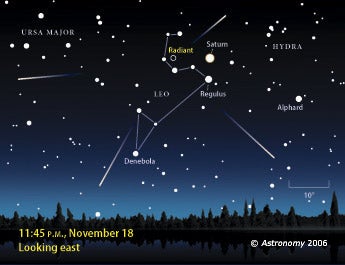
Astronomy promotes the science and hobby of astronomy through high-quality publications that engage, inform, entertain, and inspire.
November 14, 2006
Waukesha, WI – This Saturday night, the annual Leonid meteor shower could put on a good show. The meteor shower is active November 14-21, but astronomers expect heightened activity from about 11:45 P.M. until 1:33 A.M. EST November 18/19. A New Moon November 20 means moonlight won’t pose much of a problem for this year’s late-night light show.
The skinny:
In the United States, the Leonid’s radiant – the point in the sky where the meteors seem to come from – will be low in the eastern sky, which will reduce the number of visible meteors. Models indicate this year’s Leonid meteors will be less massive than in the past years, which means they won’t be as bright.
Bottom line: If people want to see Leonids this year, they’ll have to find a dark sky.
Experts at your disposal
Astronomy magazine editors are available to discuss this event. To request an interview, please contact Matt Quandt at 262.798.6484 or mquandt@kalmbach.com.
What causes a meteor shower?
As a comet passes near the Sun, heat melts the dusty ice ball. Comets are laden with dust, gas, and organic material. As a comet melts, it leaves a trail of debris in its orbital path. When Earth subsequently plows through this debris stream, particles strike Earth’s atmosphere, where they burn up and produce colorful streaks of light.
The Leonid meteor shower is the result of Comet 55P/Tempel-Tuttle’s passages about the Sun. Tempel-Tuttle has an orbital period of about 33 years, which means the comet will again reach perihelion – its closest approach to the Sun – in 2031. Then, 55P will leave more material in its wake as the Sun’s heat melts it.
David Asher of Armagh Observatory in Northern Ireland predicts a zenithal hourly rate (ZHR) of about 100 meteors for this year’s Leonid meteor shower. The ZHR is the number of meteors one can see from the direction of the Leo, the shower’s radiant.
Look to the east
Leo rises in the east on the 18th, and the constellation is high enough above the horizon for good meteor viewing around midnight. If you’re observing the shower from North America, you could see a few dozen meteors per hour from a dark-sky location.
No equipment necessary
You don’t need a telescope or binoculars to watch the Leonid meteor shower. Viewing is best away from lighted areas where you can see the eastern horizon. Warm clothing and an unobstructed view of the sky are all you need to enjoy the Leonid meteor shower.
More Astronomy resources:
Astronomy news
This week’s sky events
Astronomy basics
Glossary of astronomical terms
Return to Astronomy “For the media” page









